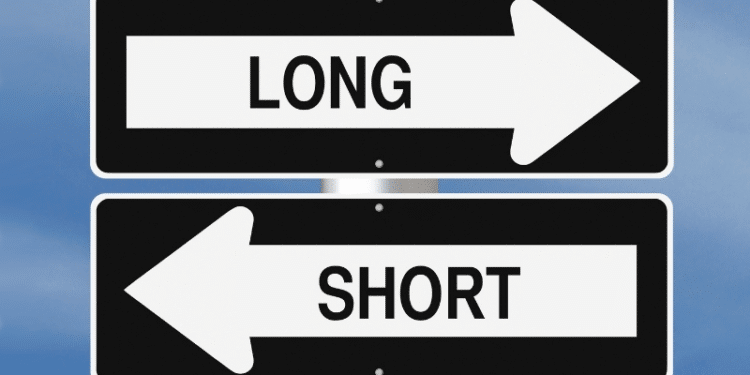In forex, as well as, stocks or cryptocurrency analysis, experts tend to describe a trader’s position as either being short or long. This is a description of what currency a trader owns, and what they need to own.
Most traders use this tool to increase returns on their investments. Forex traders deal with currency pairs, so they will always be long on one currency and short on the other. Therefore, this is a powerful tool as it is the main way one can profit from trading forex.
In this article, we will analyse the longing and shorting in forex and the risks involved.
What is shorting
Shorting is the action of obtaining a short position. This order can be carried out at any time in the forex market. To be in a short position, traders borrow the currency that they do not own and sell this to another trader. When the price of the currency decreases, the trader will repay the debt. The profit is the difference between the value of borrowing and repaying.
A short position can be seen as taking out a loan to own the currency.
There are two types of shorts, naked and covered. Although, typically the former has been banned in many countries including the United States.
Naked shorts: A trader can sell a security without having full ownership of it.
Covered shorts: A trader still borrows and sells security but pays a borrow fee for the duration of the short.
When to short
Traders normally short when they expect the currency to depreciate relative to the other currency in the pair. This normally happens in a bearish market or there are social changes to a country. The result of a conflict or scandal within the government can also be a good time to short this currency.
For example, a trader trades the GBPUSD pair at the start of 2020 with the black lives matter protests in the United States. These protests cause a depreciation in the US dollars as a result of a decrease in demand. This decrease in demand stems from the uncertainty that comes with societal unrest.
In this situation, the trader will be short on USD and long on GBP. This means, initially they will sell USD and buy GBP expecting the price of USD to fall relative to GBP. After the currency depreciates, the trader’s GBP will be used to rebuy the USD. This results in a net increase in both USD and GBP and ultimately an increase in the portfolio’s size.
What is longing
Longing is the opposite of shorting. It is the action of obtaining a long position. This order can be created at any time in the forex market. Being in a long position is achieved through the purchase of a security with the hope that it will increase in value.
Traders will buy up a currency expecting an increase in prices before selling to gain profits. This profit is the difference between the price of the currency purchased at the beginning and its price when the currency is sold – exiting the long position.
Longing has the same mechanism as capital gains in real estate, stocks, or cryptocurrency. Traders buy at a low price then resell at a higher price to gain profit.
There are three types of long positions: holding an investment, options contract, and futures contracts.
Holding an investment: When a trader buys a currency at a lower price before selling it when it appreciates.
Options contract: The trader will hold an underlying asset and has the ability to sell it at a profitable price before the contract expires.
Futures contracts: When expecting the value of a currency to go up, the buyer and seller of the currency will agree on a price of exchange. The exchange will be complete at the agreed price at the end of the contract, regardless of the market price.
When to Long
Traders are normally long when they expect a currency to appreciate relative to the other currency in the pair. This is a useful tool for a bullish market or when a government uses an expansionary policy to increase economic growth.
For example, the trader trades a GBPUSD pair, at the beginning of Donald Trump’s presidency in 2016. Trump wanted to increase the US economic growth, therefore, there is an expectation that the US dollars will appreciate in value. The dollar appreciates due to economic stimulus which leads to an increase in demand for USD.
In this situation, the trader will be long on USD and short on GBP. Initially, they will use GBP to buy USD expecting the price of USD to rise relative to GBP. After the currency appreciates, the traders sell the USD to gain profit. The profit will be the product of the quantity and margin between buying and selling price.
Risks involved
Shorting
When a trader shorts, there is a limited potential for profit and unlimited potential for losses because the lowest the price can go is to zero.
Another risk that is involved with shorting forex is the possibility of falling into the ‘short-squeeze’. This is a state where too many traders are shorting causing prices to increase as a result of those traders closing their short positions. Not being alert to market conditions or over-committing to a short can result in high losses. Losses can be further accentuated if traders use leverage.
Longing
Longing usually occurs during bull-runs. Traders in a bull market are often over-optimistic. This may lead to wrong speculations of prices where the real price of currency might start depreciating instead of appreciating.
Finally, there are many different longing options. Traders need to be aware of all the options available as well as their terms. This will help them choose the best options when switching to a long position, depending on the circumstances.




